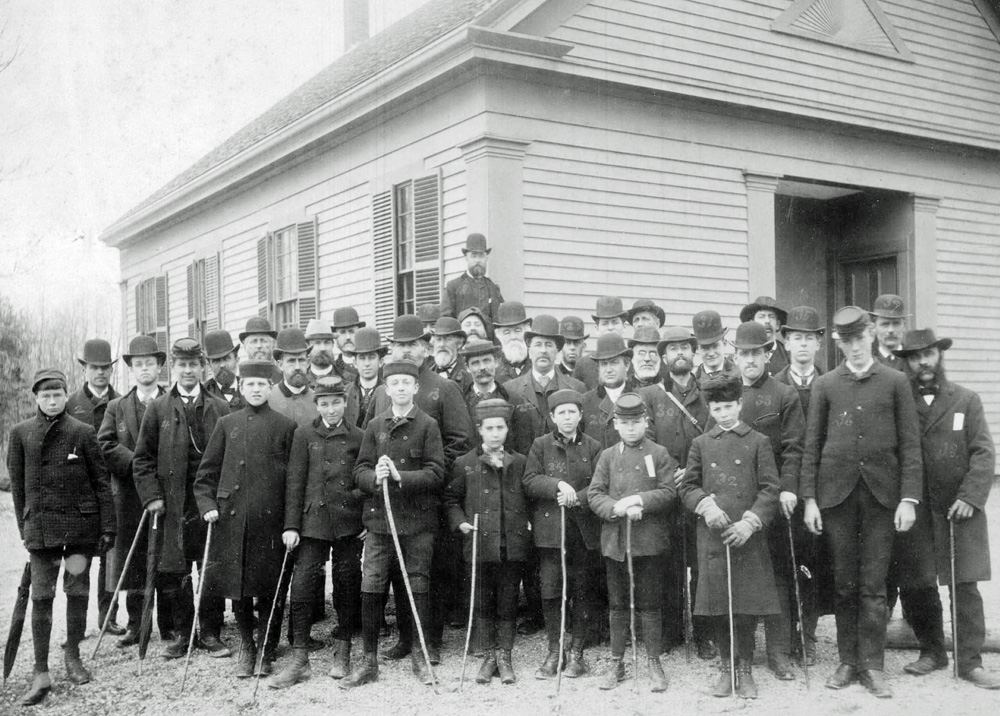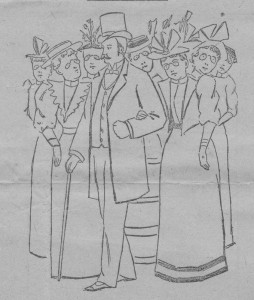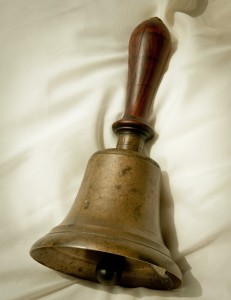True Tales: Ringing in a New School Year
By George T. ComeauThere is a dull patina to the bell that sits on my writing table. The box arrived just last week, and after prolonged negotiations with the seller, I tendered the sum of $50 for a small piece of Canton’s history.
What makes this bell special is that taped to the underside is a small piece of paper with the provenance that tells a story. “This bell was owned and used by my great grandmother, Miss Harriot McKendry, when she was the teacher of an ungraded school in Ponkapoag (part of Canton, Mass.) about 1840.”
Over 172 years ago, Miss McKendry would use this bronze bell to call her students inside from the sunny diversions of Ponkapoag. The bell chimes out loud and clear and brings the listener back to another time and place in Canton.
Our earliest school was quiet near the Blue Hill. As early as 1719 the town of Dorchester voted £20 for a “writing and reading school in the South Precinct.” This was Ponkapoag, and by 1726 a basic school was established at Robert Redman’s house since there was no building available for the singular use as a school. These early classes were basic and about 40 children gathered to learn how to spell and read as well as do simple mathematics.
The first schoolhouse proper was built in 1760, which lasted until 1799 whereupon it was moved to the Milton line. There is a wonderful scrap of paper in the Canton Historical Society — a receipt for work done at Stoughton School branch No. 2. The brittle paper is a small list of necessaries, “to Jesse Smith paying James Capen for fixing the house, for lime and rum, for finding wood for the school,” and for paying Joseph Shepard for pointing the chimney. You have to wonder what the limes and rum were for.
The new building known as the Blue Hill Schoolhouse was the schoolhouse that the bell became a part of. Overseen by William McKendry, whose house is still standing in Ponkapoag, it is likely that his daughter Harriot was employed in 1841-1842. The report on her abilities was most favorable; the 20 year old made quite an impression upon her father. The school “has maintained its former elevated character in each examination. The teacher has exerted a most happy moral as well as intellectual influence upon her pupils.” It is likely that the report was indeed written by her father, finishing up with the observation: “The activity and rapidity peculiar to the teacher increased the interest and sprightliness of the school. She succeeded well.”
We know plenty about this building, from a letter penned in 1877 by John Spare, an elderly resident, who described his childhood school in detail. The second schoolhouse, that of Miss McKendry’s days, was modest in size, about 22×28 feet, or less than 700 square feet in total. The schoolhouse had been painted red, and a single door opened into one large schoolroom. A “naked brick chimney, and an open fireplace” was between two windows at the eastern wall of the room. The long side of the room was the front of the class and a “master’s desk, made large with matched boards, looking something like a pulpit, but served as a dark dogs hole or prison where mischievous boys did penance and gathered knowledge and reflection near the feet of the master.”

The Canton Historical Society Fast Day Walk in 1886 visits the Blue Hill Schoolhouse. (Courtesy of the Canton Historical Society)
The classroom was segregated by the sexes — the girls on the north side of the room arranged on seven-foot benches, and the boys on the southern side, their benches engraved over time by “jack knife sculptures.” In 1829 a porch was added and a coal stove replaced the fireplace. The building was repainted a light yellow. Inside this building more than 70 children would learn the basics. They traveled from as far away as Green Street, and as they neared the schoolhouse, steps were cut into the surrounding fieldstone wall to make their path easier.
Age would quickly take its toll on this wooden school. A report from 1845 makes note of the fact that the school had become unfit and a “disgrace” to “the delightful situation it occupies,” referring to the stellar views of the building overlooking the Great Blue Hill. “A good School-House, invites and helps secure good teachers, and exerts a refining and elevating influence upon the pupils, of vastly more importance, than the mere saving of expense to the parents.” In short, pay for a new school — one where the “associations should be pleasant, cheerful and ennobling.”
In the early days of our educational system, the town was divided up into school precincts, and each precinct was responsible for their own curriculum, staffing, and buildings. As time moved forward, some parts of the community became more adept at educating their children, while other, perhaps poorer sections, repeatedly failed at the task. And after the 1845 report, the people of District No. 2 voted to build a new school. “Such a school-house on this spot, with its highland scenery, and in the centre of a spacious play ground ornamented with trees, will be an honor to the liberality and enlightened taste of the district.”
Slightly forward of the old building, a new school was erected in 1846 and dedicated on December 4 of that same year. The reviews were amazingly supportive, extoling the location, the architecture, the ventilation, and the “liberal extent of blackboard.” The new school featured a thermometer, a clock, and convenient play grounds. Indeed, the citizenry was lauded for their “conspicuous monument to the judicious liberality and good taste of the parents, who have bequeathed it as a valuable legacy to their posterity for generations to come.”
You would have imagined from the description that the people of Ponkapoag had built a temple of learning equal to the Parthenon. In fact, what they had built was a simple wooden one-room schoolhouse that still stands today as the Ponkapoag Chapel. The school would serve generations of children for 46 years — until a wealthy benefactor brought a new modern school to the children of Canton.
Augustus Hemenway was educated at Harvard University and came from great wealth. The Hemenway fortune had been earned through tremendous trade opportunities between South America and Boston in the early 19th century. Living upon the vast money available to Hemenway meant having the means to enjoy country living in Canton. The estate house is still standing on Green Street, and you can catch a glimpse of the grandeur of a gentlemen’s mansion if you know where to look.
In 1878, Hemenway donated the Hemenway Gymnasium to Harvard and expanded it in 1895; he also served as an overseer of the university. Hemenway supported a number of other institutions in the Boston area, including the Museum of Fine Arts, Massachusetts Eye and Ear Infirmary, Groton School, Metropolitan Park Commission, and MIT. In December 1881, he married Harriet Lawrence and they had five children. He later built homes for his children on his estate in Canton, and these houses are still tucked in the woods in and around Green Street. Hemenway served in the Massachusetts House of Representatives in 1890 and 1891. Mrs. Hemenway founded the Massachusetts Audubon Society in 1896.
But perhaps Hemenway’s greatest contribution was to the people of Canton. In 1868 the old system of individual districts was abolished and a school committee structure was put in place comprising representatives from across the community. Hemenway would see the state of our schools firsthand as a School Committee member. During a visit to the decrepit old Ponkapoag schoolhouse in 1892, he challenged each child to contribute 5 cents toward a new building. “If the children’s sum is insufficient,” pledged Hemenway, “I will make up the balance.”

An 1893 newspaper cartoon of Augustus Hemenway accompanying Canton’s bespectacled teachers to the Chicago World’s Fair
And indeed he did, building perhaps the best school in Canton on the crest of Ponkapoag Hill. Designed and built at Hemenway’s expense, it was constructed by Canton carpenter William H. Bright. The building still stands today, now in white just as you get off the highway past the Bradley Estate on route 138. Hemenway promised that the children’s names would be forever memorialized on a tablet, and today those names are framed in an illuminated print hanging in the children’s room of the Canton Public Library. The connection is simple: Hemenway, Canton’s greatest philanthropist, also donated the land, design and building of the Canton Public Library. When completed in 1902, he and his wife simply signed the deed over to the town of Canton.
So generous to the teachers of Canton was Hemenway that in 1893 he took every schoolteacher in town, at his expense, to the Chicago World’s Fair. The cost to take the 19 teachers was the equivalent of $110,000 today. The papers swooned over the idea and took a crack at the teachers, observing, “It will undoubtedly be necessary for somebody to go along who can keep this party of young women together, for some of them are very lively and of abundant animal spirits, while two at least are reported to be extraordinarily handsome.”
Like the bell that Harriot McKendry rang almost two centuries ago, our schools are a lasting symbol to our unlimited generosity and our deeply principled interest in the welfare and education of our children. Our commitment rings back to our first settlers and will continue beyond as our enduring legacy to Canton.
Short URL: https://www.thecantoncitizen.com/?p=15665











